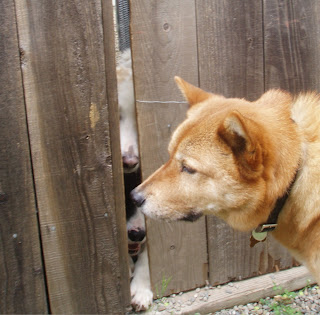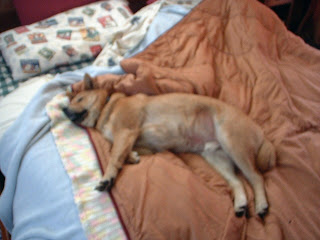 |
| Some dogs are more sensitive to sounds than others |
Not all dogs react to sound in the same manner. While some dogs are sound specific, most dogs
that are considered “noise phobic” or “sound sensitive” tend to be particularly
frightened of loud low range sounds like fireworks and thunder. July fifth is the busiest day for animal
shelters picking up dogs found wandering the streets, dogs that jumped over
fences or broke through gates during Fourth of July fireworks. Along with keeping animals indoors during
times that we know are potentially frightening (New Year’s Eve, Fourth of July,
and during storms) there are other ways to assist them.
It is possible to desensitize most animals to loud
sounds. Puppies born during storm
season or exposed to loud noises while still with their mother (assuming the
mother isn’t frightened), can be less sensitive to sound. Playing recordings of sounds and explosions
at a very low level on a stereo, while feeding the dog treats, and then very
gradually increasing the volume over several sessions can also help. But, desensitization is a long and delicate
process. It’s important to consider how
frequently the dog will be exposed to “real life” scary sounds. If thunder/fireworks only happen a few times
a year, it might be more practical to seek ways of managing the sound and the
dog’s reaction.
Panic and fear reactions to sound aren’t consistent. Some dogs pace and run. Others seek cover in tight or enclosed areas,
although it is never advisable to crate a frightened dog. An
interior room, one with no windows and no outward walls, will carry less sound
and therefore be quieter. Padding the
flooring with throw rugs can further muffle sound. Add a covered crate with the door left open, and some dogs will declare that their safe
haven, especially if family members are there as well. There are also devices (Thundershirts is one)
that wrap around a dog’s body, similar to swaddling babies, which use
compression and pressure points to soothe.
Dogs that pace and try to run would also fare better in the quietest
room, but wraps and crates will make them more anxious.
Diffusing and muffling the sound can help as well. Windows and outside doors should be
shut. Blinds and curtains should be
drawn as well, both to add another sound barrier and to prevent added
associations to sound – like flashes of light – from becoming panic
triggers. Basements have the
surrounding ground to muffle sound as well as having a slab floor. Carpeting
and rugs also keep sound from transferring. Turning on ambient sound, such as a fan, can
help, as can turning up the television.
If the dog is accustomed to music with a bass, playing music with a
thumping bass, with the bass speakers face down on the floor can help disguise other
rumblings.
There are also over the counter herbal preparations that can
help take the edge off of dogs’ anxiety.
Most contain tryptophan and chamomile, generally harmless
ingredients. However, it’s always best
to consult with a vet first to make sure.
For severely anxious dogs, medication can be prescribed, but it’s best
to try them during a neutral time first to know if it’s the right fit for the
dog. Some medications have a paradoxical
effect.
While it requires a bit of planning to prepare for storms or
fireworks, some dogs can start to associate the preparations with “something
bad” about to occur, which can also start panic. Practicing what to do when there isn’t a storm or fireworks can help break up any
negative associations. Wearing the
Thundershirt at arbitrary moments, hanging out in the “quiet room,” and playing
dance music during calmer times, preferably while eating snacks or getting
belly rubs, can build additional positive associations with the plan, making
the end result more potent.
Finally, it’s not true that offering comfort to a fearful
dog rewards fearfulness. Dogs need
assurance that all is well, just like people.
However, assurances are just that: assurances. If there aren’t solutions or a plan in in place
to help mitigate the fear, there will be
no resolution. And that’s not very
reassuring.




















